How to Reduce LDL Cholesterol — and Keep It Down Without Statins
Learn how to reduce LDL cholesterol and keep it low — all without relying on statins. Real lifestyle strategies that work long-term.
Keeping your cholesterol in check isn’t just a doctor’s suggestion—it’s a life-saver. According to the CDC, nearly 40% of American adults have high cholesterol, and many remain unaware until complications arise.
The good news? You don’t always need statins to fix it. With the right lifestyle tweaks, you can lower your LDL (the “bad” cholesterol), boost your HDL (the “good” kind), and protect your heart for the long run.
Let’s walk through realistic, everyday strategies you can actually stick with—no pharmacy trip required.
What is LDL Cholesterol — and Why It’s Called the “Bad Cholesterol”?
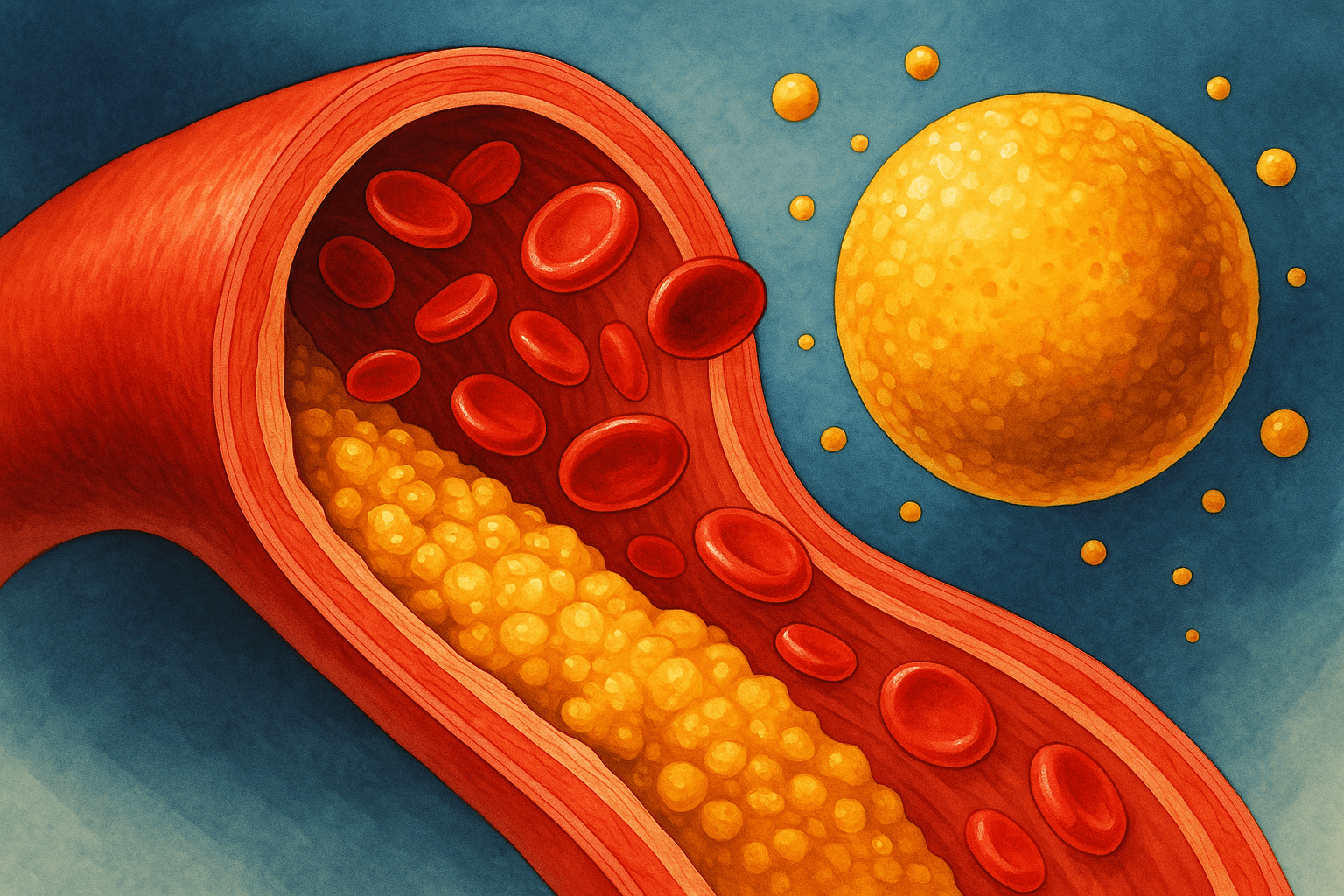
LDL stands for low-density lipoprotein. Doctors call it the “bad cholesterol” because too much of it builds up in your arteries. Over time, this can block blood flow and raise the risk of heart disease and stroke.
According to the CDC, about 93 million U.S. adults have high cholesterol, and many don’t know it until they face health problems. That’s why learning how to reduce LDL cholesterol is so important.
When LDL gets too high, it sticks to the walls of your blood vessels. This creates plaque, which makes arteries narrow and stiff. On the other hand, HDL cholesterol (the “good cholesterol”) helps clean up extra cholesterol from the blood.
Key facts to remember:
-
High LDL cholesterol = higher risk of cardiovascular disease.
-
HDL cholesterol = protective, helps keep arteries clear.
-
Balance matters: you need lower LDL and higher HDL for good heart health.
Dr. Donald Lloyd-Jones, American Heart Association, explains: “Keeping LDL cholesterol low is one of the most important things you can do to prevent heart disease.”
Understanding Cholesterol Levels: What’s a Healthy Range?
Your LDL level is the number doctors watch most closely, since high values raise the risk of heart disease. So, what numbers should you look for on your test results? Here’s a simple guide:
-
LDL cholesterol (bad): Below 100 mg/dL is optimal.
-
HDL cholesterol (good): Above 40 mg/dL for men, 50 mg/dL for women. Higher is better.
-
Total cholesterol: Under 200 mg/dL is considered healthy.
-
Triglycerides: Keep them below 150 mg/dL.
The difference between good cholesterol (HDL cholesterol) and bad cholesterol
| Aspect | Good Cholesterol (HDL) | Bad Cholesterol (LDL) |
|---|---|---|
| Full Form | High-Density Lipoprotein | Low-Density Lipoprotein |
| Role in the Body | Removes excess cholesterol from the blood and carries it back to the liver for disposal | Deposits cholesterol in the arteries, which can build up over time |
| Health Impact | Protects the heart and lowers risk of heart disease and stroke | Increases the risk of clogged arteries, heart attack, and stroke |
| Nickname | “Good” cholesterol | “Bad” cholesterol |
| Optimal Levels | Higher levels are better (above 40 mg/dL for men, above 50 mg/dL for women) | Lower levels are better (below 100 mg/dL is optimal) |
| Food Sources that Increase It | Olive oil, fatty fish (salmon, tuna), nuts, seeds, whole grains | Fried foods, processed snacks, red meat, full-fat dairy, trans fats |
| Effect on Arteries | Helps keep arteries clear by removing plaque | Contributes to plaque buildup and narrowing of arteries |
How to Reduce LDL Cholesterol Naturally: Lifestyle Changes That Work
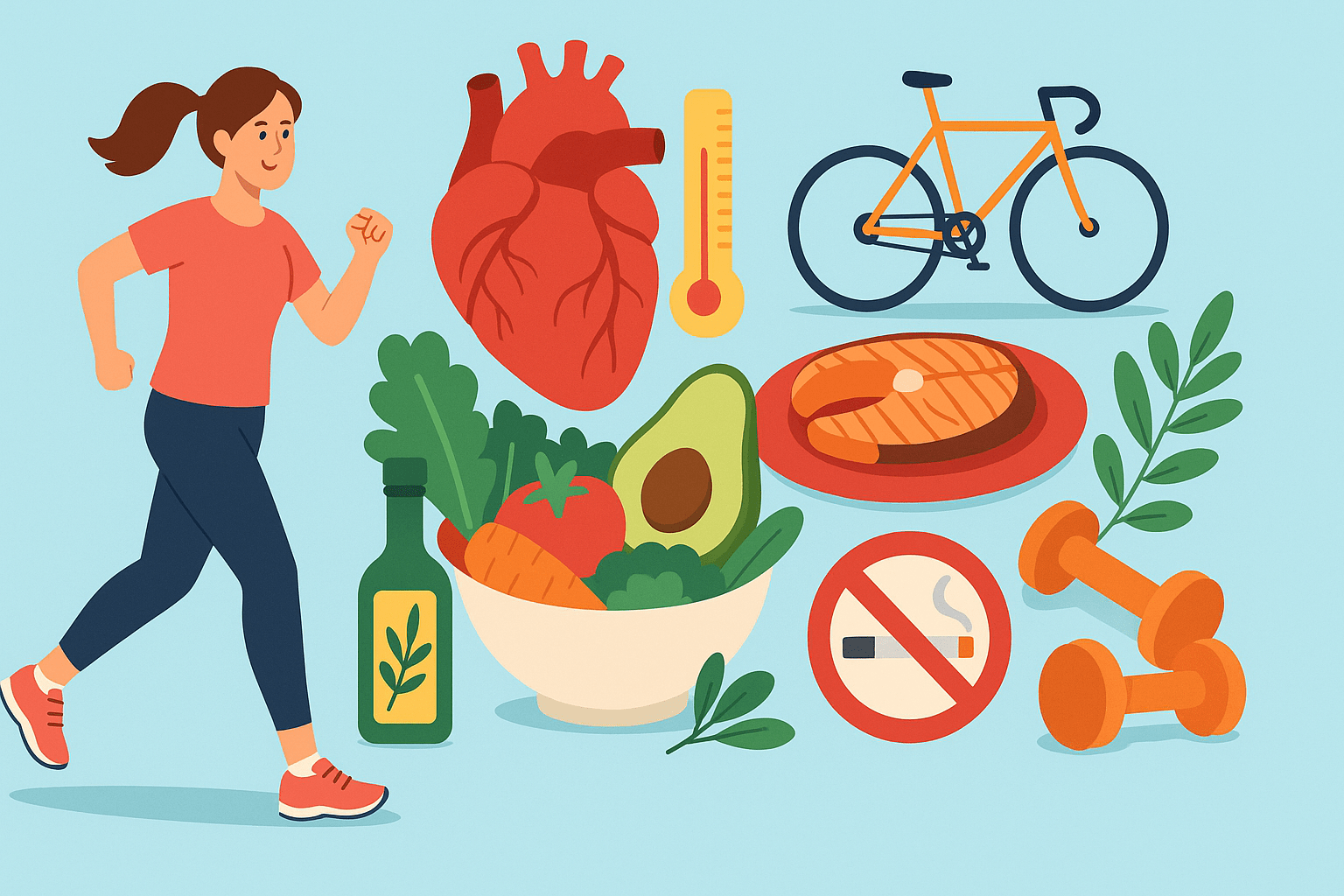
1. Move Your Body Every Day
Physical activity is one of the easiest ways to improve cholesterol levels. When you exercise, your body raises HDL cholesterol (the “good cholesterol”) and lowers LDL cholesterol (the “bad cholesterol”).
-
Aim for 30 minutes a day, at least 5 days a week.
-
Walking, cycling, swimming, or even dancing count as exercise.
-
Try taking the stairs instead of the elevator or walking to the store instead of driving.
2. Maintain a Healthy Weight
Being overweight increases bad cholesterol and raises your risk of heart disease and high blood pressure. Even small weight loss helps your body find a healthier balance.
-
Focus on weight management instead of crash diets.
-
Add more whole grains, fruits, and vegetables to meals.
-
Limit processed foods, sugary drinks, and foods high in saturated fat.
-
Track your progress—losing just 5–10% of your body weight can lower LDL and improve heart health. Once you reach a healthy weight, overweight becomes less likely.
💡 Dr. Frank Hu, Harvard School of Public Health, explains: “Even modest weight loss can helpyou lose weight, reduce cholesterol and improve cardiovascular health.”
“Take control of your cholesterol with meals designed for you. Balance Bite offers science-backed nutrition plans that fit your lifestyle.”
3. Choose Heart-Healthy Fats
Not all fats are bad. The problem comes from saturated fat (found in fatty meats, full fat dairy, coconut oil, and palm oil) and trans fats (in processed foods made with partially hydrogenated vegetable oils).
These raise LDL cholesterol. Healthy fats like olive oil, canola oil, vegetable oils, and polyunsaturated fats can do the opposite—support your heart health and help keep LDL lower.
How to implement it:
-
Replace butter with extra virgin olive oil.
-
Grill or bake instead of frying.
-
Eat more fatty fish like salmon or sardines twice a week.
-
Snack on nuts and seeds instead of chips.
4. Limit Trans Fats Completely
Trans fats are man-made fats found in fried foods, baked snacks, and items made with partially hydrogenated vegetable oils. They increase bad cholesterol (LDL) and lower good cholesterol (HDL). This double hit makes them very dangerous for heart health.
-
Read food labels and avoid anything with “hydrogenated oils.”
-
Skip fried fast foods, packaged cookies, and margarine.
-
Replace them with heart healthy foods like nuts, seeds, and olive oil.
5. Add More Soluble Fiber
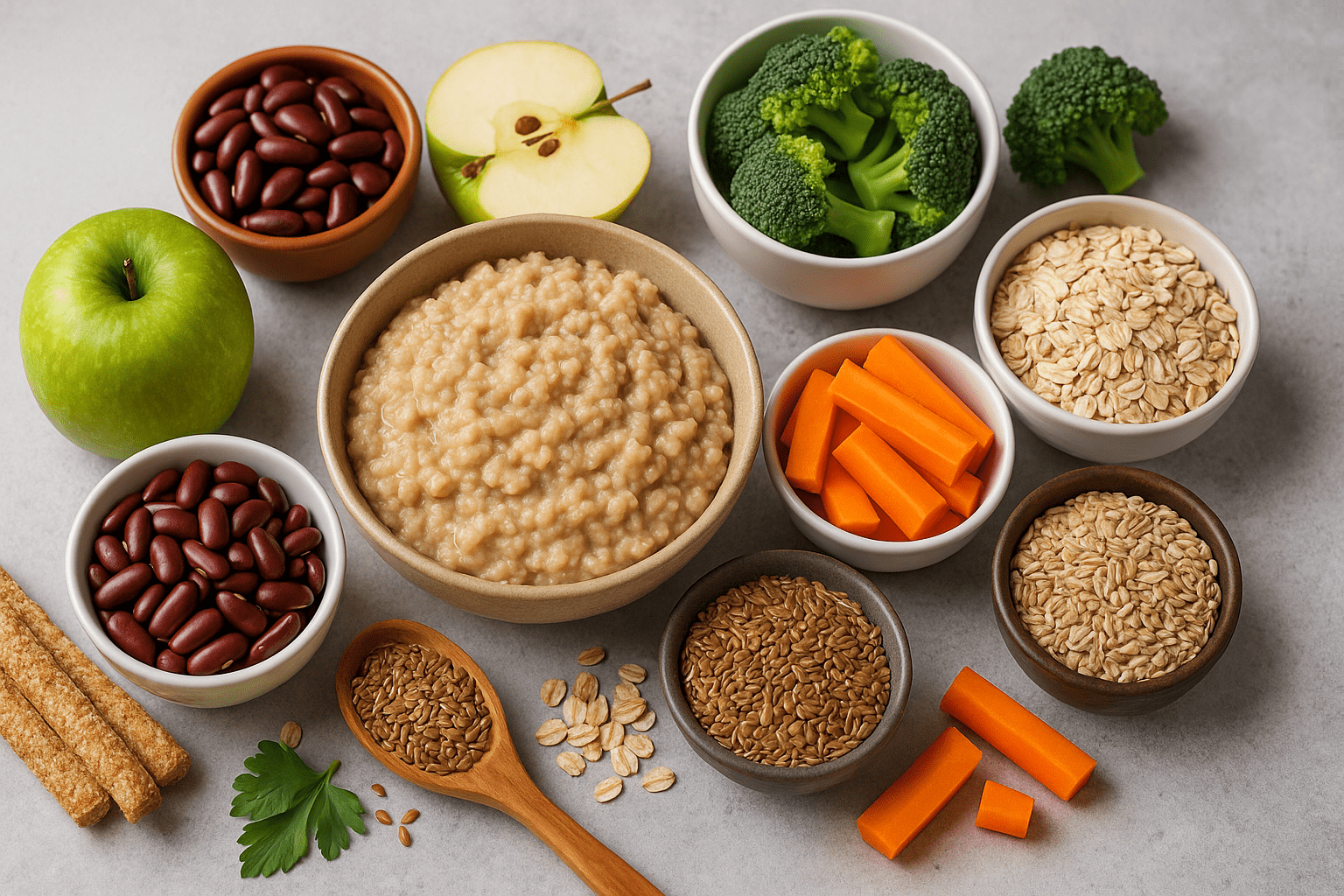
Soluble fiber traps cholesterol in your digestive tract so your body can remove it before it enters your blood. This helps lower LDL cholesterol naturally. Foods like oats, kidney beans, apples, and barley are great sources.
-
Start your day with oatmeal or whole grain cereal.
-
Add beans or lentils to your lunch.
-
Snack on fruit instead of chips.
When you eat foods rich in fiber, whole grains, and healthy fats, your LDL level drops over time.
6. Cut Down on Alcohol
Drinking too much alcohol raises cholesterol and triglyceride levels. It can also lead to weight gain and high blood pressure. All of these raise the risk of cardiovascular disease.
-
Limit alcohol to 1 drink a day for women and 2 for men (CDC guidelines).
-
Choose water, sparkling water, or herbal tea as daily drinks.
-
Save alcohol for special occasions instead of making it a routine.
7. Quit Smoking for Good
Smoking lowers HDL cholesterol (the good cholesterol) and damages your blood vessels. This raises the risk of atherosclerotic cardiovascular disease.
-
Make a quit plan—pick a date and stick to it.
-
Get help from support groups, apps, or your doctor.
-
Replace smoking with healthier habits like chewing sugar-free gum or walking.
8. Follow the TLC Diet
The Therapeutic Lifestyle Changes (TLC diet) is recommended by the National Heart, Lung, and Blood Institute. It focuses on lowering LDL cholesterol through healthy eating.
-
Limit foods high in saturated fat and trans fats.
-
Add more whole grains, fruits, vegetables, and soluble fiber.
-
Use healthy fats like olive oil, canola oil, and vegetable oils.
-
Include lean meats or plant proteins instead of fatty meats.
9. Manage Stress Levels
Stress can cause unhealthy behaviors—overeating, drinking too much alcohol, or smoking—that raise cholesterol levels. Chronic stress also raises blood pressure.
-
Try relaxation methods like yoga, meditation, or deep breathing.
-
Take short breaks during work to move and reset.
-
Spend time outdoors or with friends to improve heart health.
10. Healthy Eating for Long-Term Heart Health
Healthy eating is not just a diet—it’s a lifestyle. Eating smart as part of a healthy lifestyle keeps cholesterol levels in the healthy range and prevents health problems.
-
Build meals around heart healthy foods like fatty fish, whole grains, nuts, and extra virgin olive oil.
-
Avoid processed foods, red meat, palm oil, and full fat dairy products.
-
Keep portions balanced to support weight management and reduce risk factors for cardiovascular disease.
Eat Heart-Healthy Foods: What to Add to Your Diet
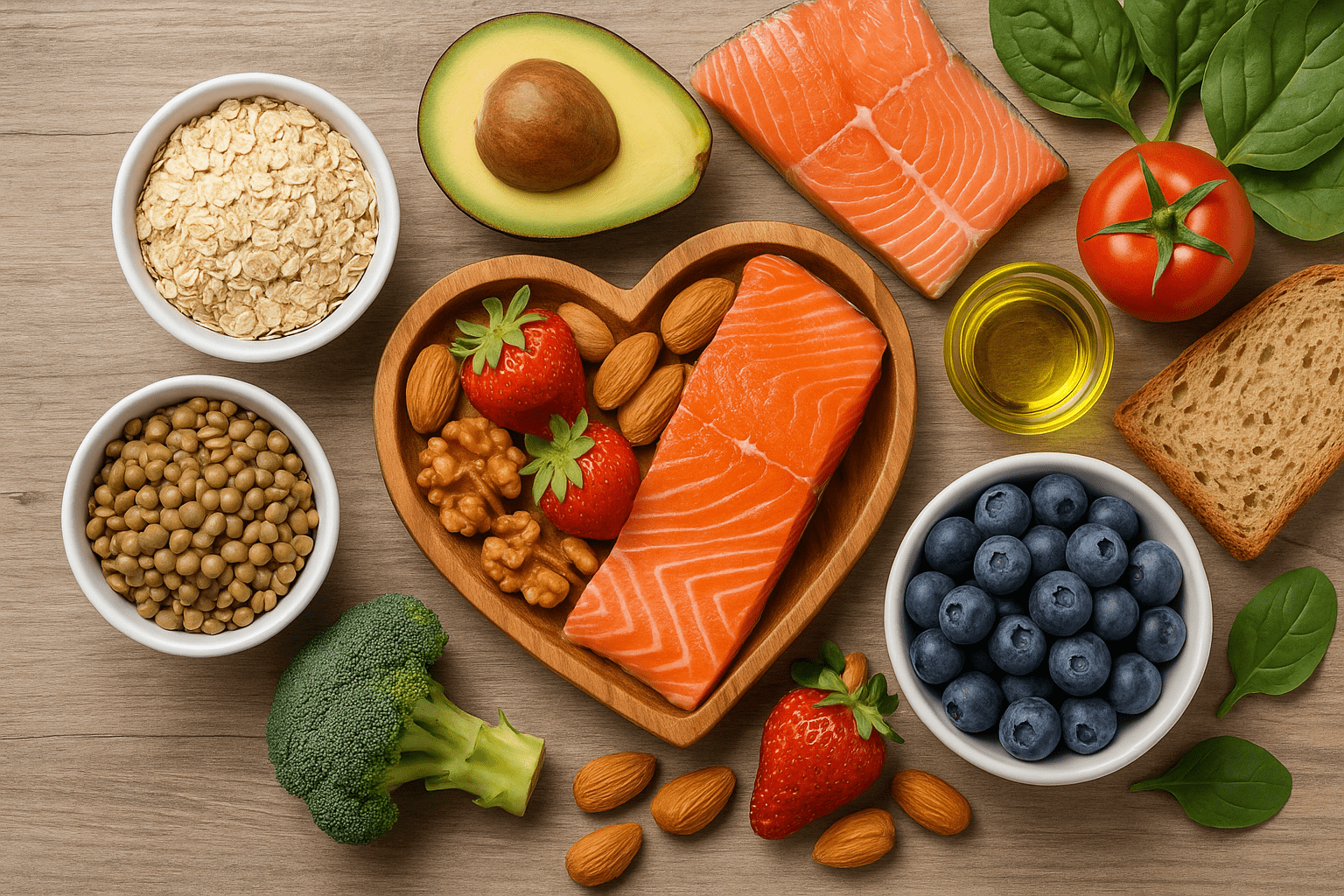
1. Eat More Fatty Fish
Fatty fish like salmon, tuna, and mackerel are rich in omega-3 fatty acids. These healthy fats lower cholesterol and triglyceride levels and support heart health.
-
Eat fatty fish at least twice a week.
-
Grill, bake, or steam fish instead of frying.
-
Replace processed meats or red meat with fish to avoid saturated fat.
2. Go for Whole Grains
Whole grains like oats, barley, brown rice, and whole wheat bread contain soluble fiber. This fiber binds cholesterol in the digestive tract and helps your body remove it.
-
Start your morning with oatmeal topped with fruit.
-
Swap white bread or refined rice for whole wheat and brown rice.
-
Try quinoa or barley in salads and soups.
The National Heart, Lung, and Blood Institute notes that 5–10 grams of soluble fiber daily can reduce LDL cholesterol by 5–10%.
3. Enjoy a Rainbow of Fruits and Vegetables
Fruits and vegetables are low in calories and packed with vitamins, minerals, and antioxidants. They improve cholesterol levels, lower blood pressure, and protect your blood vessels, providing various health benefits .
-
Fill half your plate with colorful vegetables.
-
Snack on apples, berries, or carrots instead of chips.
-
Add leafy greens like spinach and broccoli to dinner.
4. Use Extra Virgin Olive Oil Daily
Extra virgin olive oil is packed with healthy fats. Unlike coconut oil or palm oil, it does not raise bad cholesterol. Instead, it helps lower LDL and supports your blood vessels.
-
Use olive oil for salads and light cooking.
-
Replace butter or margarine with olive oil spread.
-
Mix a spoon of olive oil into cooked vegetables.
5. Snack on Nuts and Seeds
Nuts and seeds have polyunsaturated fats and fiber. These help lower LDL cholesterol while raising HDL, the good cholesterol.
-
Eat a handful of almonds, walnuts, or pistachios as snacks.
-
Add chia seeds or flaxseeds to yogurt or smoothies.
-
Replace chips or cookies with mixed nuts.
6. Add Lean Proteins
Protein is important, but not all sources are equal. Fatty meats and processed meats are high in saturated fat. These raise cholesterol levels. Lean options like chicken breast, turkey, tofu, or lentils help reduce LDL.
-
Choose grilled or baked lean meats instead of fried.
-
Swap red meat for beans or lentils twice a week.
-
Look for “lean” labels when buying cuts of meat.
7. Keep Dairy in Check
Dairy can be healthy, but full fat dairy products like cream and cheese contain high saturated fat content. This increases LDL cholesterol and raises risk factors for cardiovascular disease.
-
Switch to low-fat or fat-free milk and yogurt.
-
Limit cheese and butter in daily meals.
-
Try plant-based options like almond or soy milk if you like variety.
"Confused about what to eat? Balance Bite simplifies healthy eating with ready-to-follow diet charts, tasty recipes, and expert guidance.”
Foods to Avoid in High Cholesterol: What Hurts Heart Health
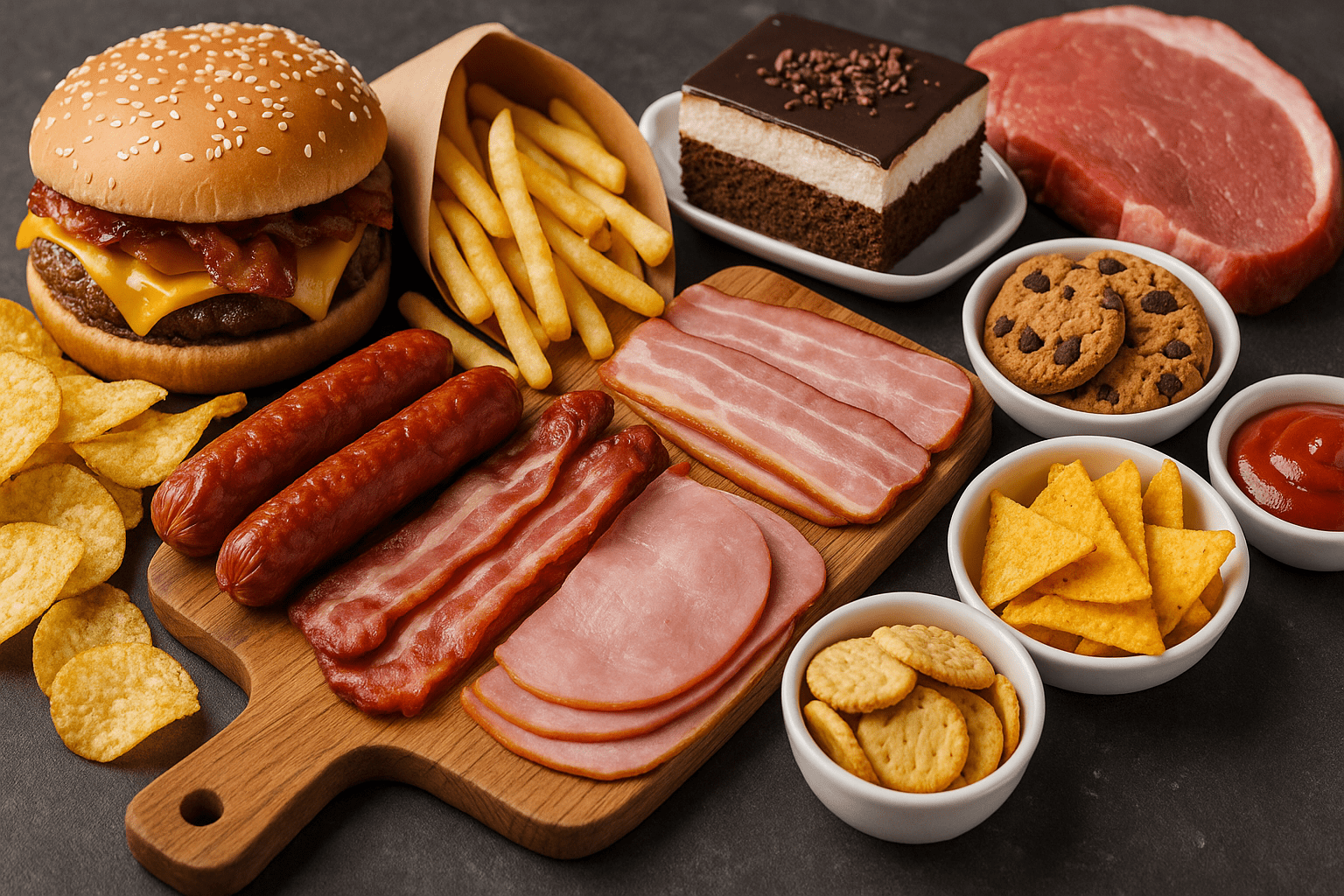
1. Fatty Meats and Processed Meats
Bacon, sausages, hot dogs, and deli meats are high in saturated fat and trans fats. These fats raise LDL cholesterol and lower HDL cholesterol.
-
Replace fatty meats with lean meats like chicken or turkey.
-
Try beans, lentils, or tofu as protein swaps.
-
Limit processed meats to special occasions only.
2. Full Fat Dairy Products
Butter, cream, cheese, and whole milk have high saturated fat content. This pushes LDL cholesterol higher and harms heart health.
-
Switch to low-fat or fat-free milk and yogurt.
-
Use olive oil instead of butter in cooking.
-
Enjoy cheese in small portions.
3. Red Meat in Excess
Beef, lamb, and pork are high in saturated fat. Eating too much raises cholesterol levels and increases risk factors for cardiovascular disease.
-
Limit red meat to once or twice a week.
-
Choose smaller portions (3–4 ounces).
-
Pick lean cuts when you do eat it.
4. Palm Oil and Coconut Oil
These oils are often marketed as healthy, but they contain lots of saturated fat. Too much raises LDL cholesterol.
-
Cook with extra virgin olive oil, canola oil, or vegetable oils instead.
-
Read food labels—many packaged snacks use palm oil.
5. Processed and Junk Foods
Chips, cookies, cakes, and fried fast food often contain trans fats and hidden partially hydrogenated vegetable oils. These damage blood vessels and raise LDL cholesterol fast.
-
Skip fried snacks and sugary desserts.
-
Choose fresh fruits, nuts, or air-popped popcorn as snacks.
-
Always check food labels for trans fats.
“Lower your cholesterol without the guesswork. Try Balance Bite’s customized meal plans, built to keep your heart healthy and strong.”
The Role of HDL Cholesterol: Raising the “Good” Cholesterol
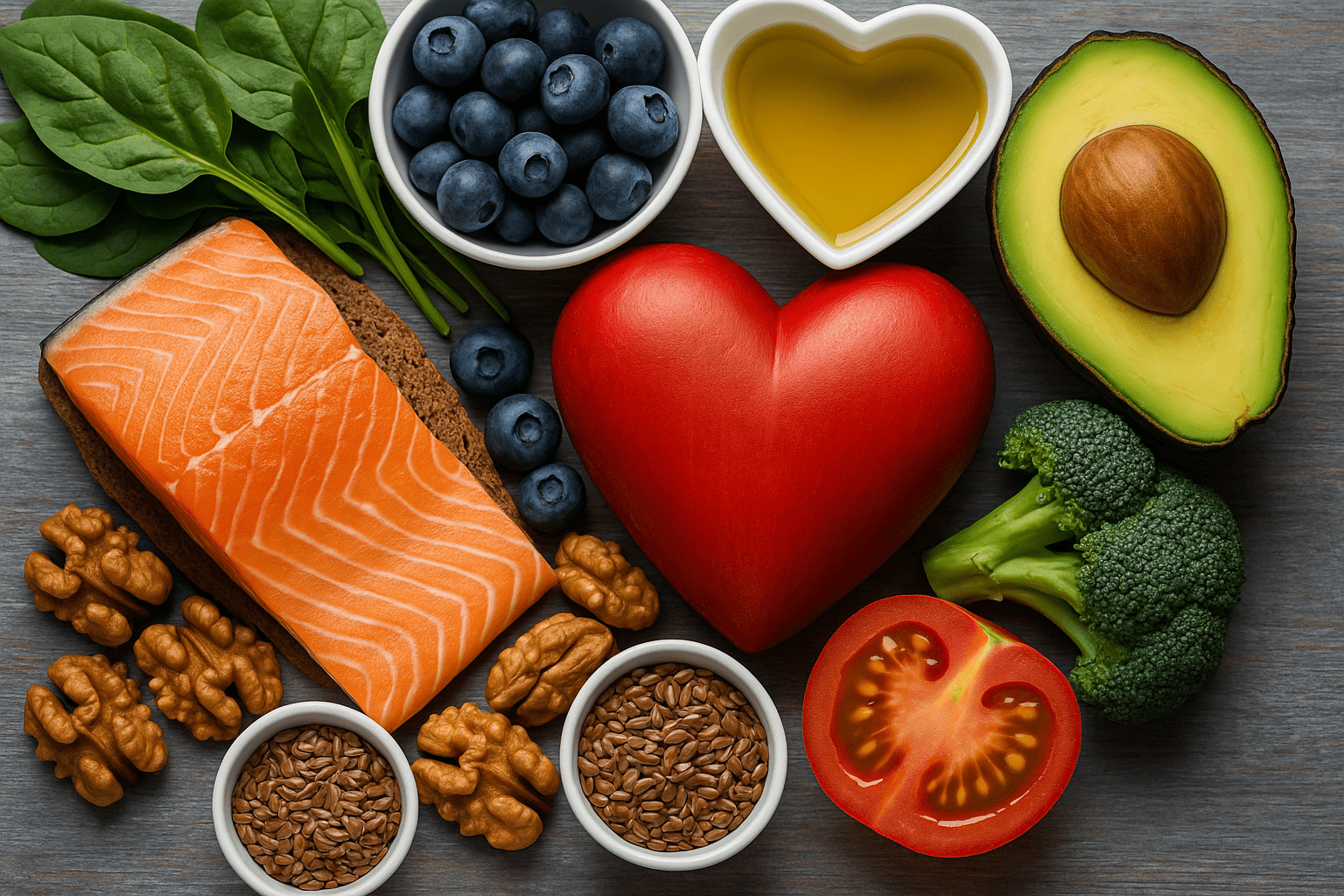
HDL stands for high-density lipoprotein. It’s called the “good cholesterol” because it helps clear extra cholesterol from your blood and carries it back to the liver. Higher HDL levels protect your heart health and lower your risk of cardiovascular disease.
While you focus on how to reduce LDL cholesterol, remember that raising HDL is just as important. You can boost HDL through regular physical activity, healthy eating, soluble fiber, and by avoiding trans fats and too much alcohol.
Beyond Food: Risk Factors and Preventive Steps
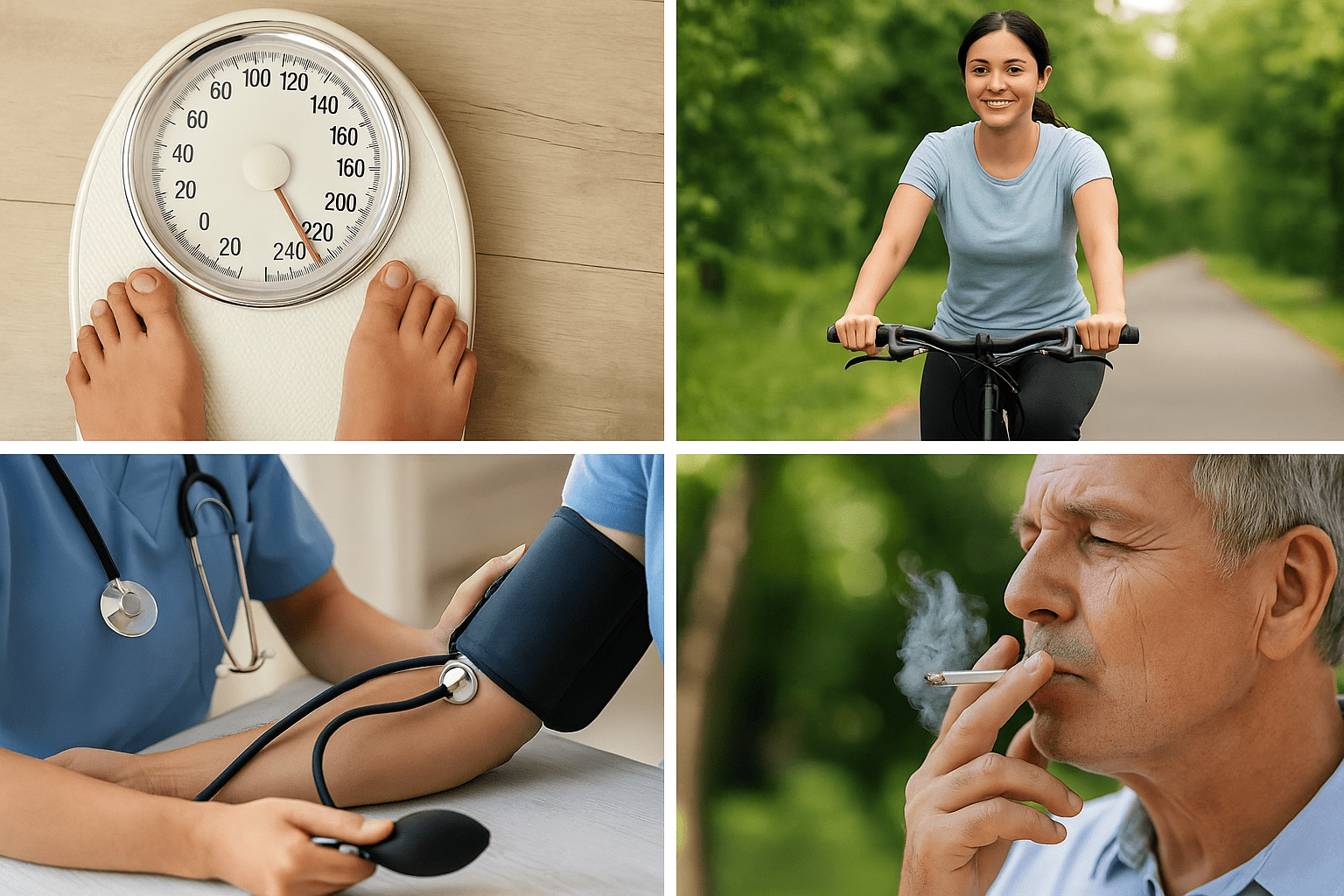
1. Watch Your Weight
Being overweight raises bad cholesterol and increases the risk of cardiovascular disease. Extra body fat, especially around your belly, can make LDL cholesterol rise and HDL cholesterol fall.
-
Track your weight regularly.
-
Focus on weight management instead of crash diets.
-
Replace processed foods with whole grains, fruits, and vegetables.
-
Even losing 5–10% of body weight can lower LDL cholesterol and improve heart health.
2. Stay Physically Active
Physical activity helps lower LDL cholesterol and raise HDL cholesterol. Exercise also keeps your blood vessels flexible and reduces risk factors for atherosclerotic cardiovascular disease.
-
Aim for 30 minutes a day, 5 times a week.
-
Walking, cycling, or swimming all count.
-
Take the stairs, garden, or play with your kids—movement matters.
3. Manage Blood Pressure
High blood pressure damages artery walls. This makes it easier for cholesterol to stick and form plaque. Over time, this raises the risk of heart disease and stroke.
-
Limit salt and avoid processed foods.
-
Eat more heart healthy foods like beans, nuts, and fatty fish.
-
Manage stress with yoga, meditation, or deep breathing.
-
Check your blood pressure at home or at your doctor’s office.
4. Quit Smoking
Smoking damages your blood vessels and lowers high density lipoprotein (HDL) cholesterol (the “good cholesterol”). When HDL drops, your body cannot clear LDL cholesterol effectively. This leads to plaque buildup and raises your risk of heart disease.
-
Pick a quit date and share it with family or friends.
-
Use nicotine patches, gum, or join a support program.
-
Replace smoking with healthy habits, like walking or chewing sugar-free gum.
5. Follow Medical Guidance
Sometimes lifestyle changes alone are not enough. Doctors can guide you on treatment options, including medical education on tests to check your cholesterol levels and risk factors for cardiovascular disease.
-
Schedule regular check-ups and blood tests.
-
Ask your doctor about the TLC diet (Therapeutic Lifestyle Changes) recommended by the National Heart, Lung, and Blood Institute.
-
Take prescribed medicine only if your doctor says it’s needed.
6. Manage Stress
Stress may not seem linked to cholesterol, but it affects your body. Stress can lead to overeating, drinking too much alcohol, and less physical activity. These habits raise bad cholesterol and blood pressure.
-
Try deep breathing, yoga, or short walks during the day.
-
Keep a regular sleep schedule.
-
Spend time with family, friends, or hobbies that relax you.
Sample Cholesterol Control Plan: From Diet to Lifestyle
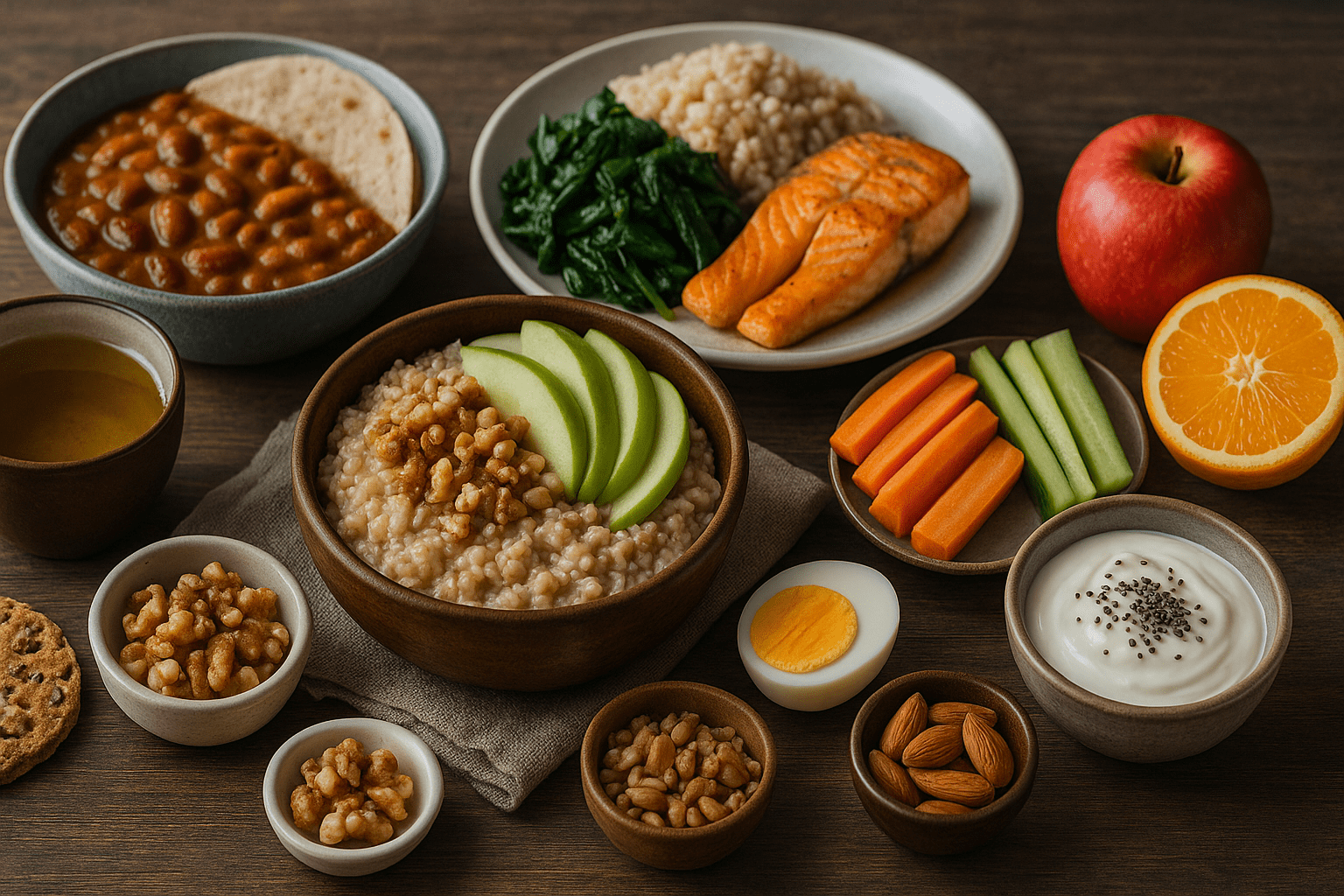
Breakfast
-
A bowl of oatmeal topped with apple slices, walnuts, and a drizzle of extra virgin olive oil
-
1 boiled egg (optional for lean protein)
-
Green tea or black coffee without sugar
Mid-Morning Snack
-
A handful of almonds or walnuts (rich in healthy fats)
-
1 orange or pear for fiber and antioxidants
Lunch
-
Brown rice or whole grain chapati
-
1 cup of kidney beans or lentil curry (excellent soluble fiber source)
-
Steamed or stir-fried vegetables cooked with olive oil or canola oil
-
Grilled fatty fish (salmon, mackerel, or sardines) twice a week instead of red meat
Afternoon Snack
-
Low-fat yogurt with chia seeds or flaxseeds
-
A small bowl of cucumber and carrot sticks
Dinner
-
Whole grains (quinoa or multigrain roti)
-
Grilled chicken breast or lean meats (if non-vegetarian) / tofu or paneer (if vegetarian)
-
Lightly sautéed spinach, broccoli, or beans in vegetable oils (not coconut or palm oil)
-
Side salad with tomato, cucumber, and a drizzle of olive oil
Before Bed (Optional)
-
A cup of warm turmeric milk (using low-fat milk) or herbal tea
“Balance Bite makes healthy eating easy. From fiber-rich breakfasts to smart snacking tips, get daily guidance to support your cholesterol goals.”
Final Note
Lowering LDL cholesterol takes time, but small steps add up.“Even simple lifestyle changes like walking daily and eating smart can lower your cholesterol naturally.
Focus on a mix of healthy eating, physical activity, and regular check-ups. Choose lean meats, limit full fat dairy, and read food labels to avoid hidden trans fats.
Use extra virgin olive oil instead of butter, and add foods high in fiber like beans and whole grains. These habits support a healthy weight and a stronger heart.
Remember, your body’s ability to heal improves when you make consistent changes. Doctors often remind patients that lifestyle is the best way to prevent cholesterol problems before they start.
If you follow a therapeutic lifestyle and stay motivated, you can keep cholesterol in a healthy range without stress. Start today with one small change, and you’ll be closer to your goal of learning how to reduce LDL cholesterol and live healthier.
“Your health journey doesn’t need to be overwhelming. With Balance Bite, you’ll learn exactly how to reduce LDL cholesterol and keep it low—naturally.”




















Leave a comment
Translation missing: en.blogs.comments.discription